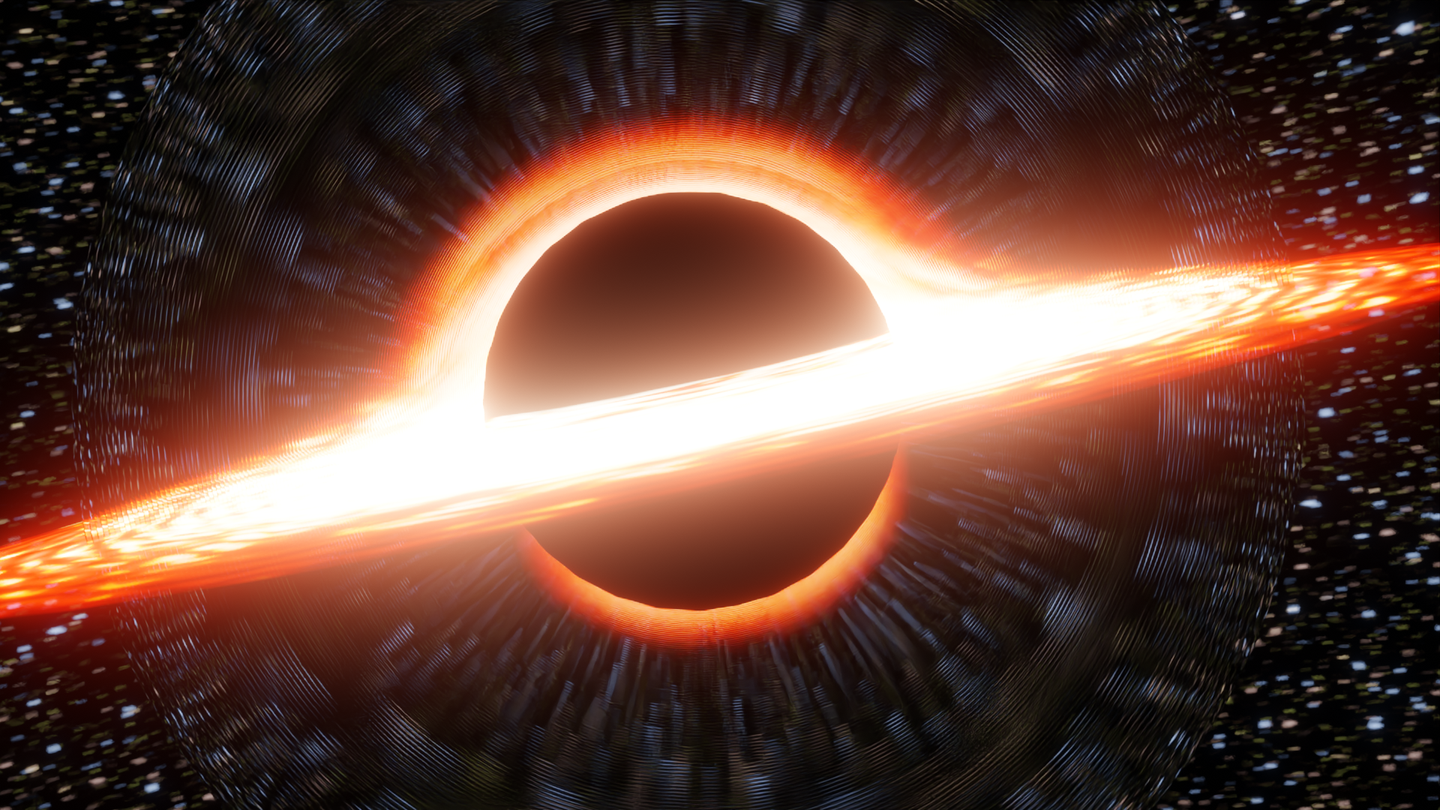Graduate student makes enlightening black hole discovery
Light behaves in surprising ways near a black hole. Photons that venture too close are swallowed without trace.

Light warps as it passes near black holes, looping around them to produce countless mirrored versions of the cosmos. (CREDIT: CC BY-SA 4.0)
Black holes continue to grip our imagination. These cosmic powerhouses twist space and time so intensely that even light cannot escape once it crosses a certain boundary. Their defining edge—the event horizon—marks a point of no return. For scientists, black holes offer a rare window into the behavior of gravity under extreme conditions.
Light behaves in surprising ways near a black hole. Photons that venture too close are swallowed without trace. But others, lucky enough to skim just outside the danger zone, may escape—though not without a wild ride. Some of these photons circle the black hole many times before breaking free.
The area where this dance of light unfolds is called the photon-sphere. It's a fragile boundary where photons spiral in unstable orbits. These orbits teeter on a knife’s edge—any disturbance can send light either plunging inward or spiraling outward into space.
As photons near this boundary, they make more loops around the black hole. From a distance, this looping light creates a stunning effect. Observers can see a distorted, layered reflection of the universe, wrapped around the black hole’s silhouette like a cosmic hall of mirrors.
This visual trick isn't just captivating—it’s mathematically precise. The closer light gets to the event horizon, the more tightly it's bent. Each orbit stacks another layer of cosmic imagery, drawing a fine, luminous map of space stretched around the black hole’s edge.
For decades, researchers have probed this phenomenon. They’ve found that the angle of light’s deflection grows logarithmically near the horizon. New work builds on this, offering sharper models of how photons behave and how small changes in their paths grow rapidly—providing new tools to decode the complex physics at play.
A Groundbreaking Analytical Framework
A groundbreaking approach has reframed this phenomenon by analyzing light’s trajectory near black holes using second-order differential equations. This methodology examines the stability of photon paths, revealing that deviations from the photon-sphere grow exponentially.
Related Stories
Each additional orbit forms an exponentially thinner ring around the black hole, creating a visual cascade of images. This insight not only deepens our understanding of gravitational lensing but also highlights the dueling exponential forces shaping these trajectories.
The method's flexibility allows it to be applied to various types of black holes, including rotating ones. This extension has revealed how black hole spin influences the spatial arrangement of photon paths.
For example, in spinning black holes, prograde (forward-moving) images become more closely spaced, while retrograde (backward-moving) ones spread out. This discovery opens new avenues for exploring black hole dynamics.
The Mathematics Behind the Phenomenon
While gravitational lensing has been a well-studied concept, a recent development has shed new light on the phenomenon’s underlying mathematics.
Albert Sneppen, a student researcher at the Niels Bohr Institute, uncovered an elegant proof explaining why repeated images near a black hole are separated by a specific factor.
Published in Scientific Reports, his work reveals the physical and mathematical intuition behind this factor, deepening our grasp of gravitational lensing.
Sneppen’s work demonstrates that each successive image requires observing 500 times closer to the black hole than the previous one. This factor, deeply rooted in the fundamental nature of gravity, provides a unique way to test Einstein’s theories.
As Sneppen noted, “There is something fantastically beautiful in now understanding why the images repeat themselves in such an elegant way.”
Insights into Rotating Black Holes
The implications of Sneppen’s findings extend beyond static black holes. All black holes rotate to varying degrees, and their spin significantly alters the gravitational lensing process.
In rapidly spinning black holes, the separation factor for successive images drops significantly. Instead of needing to look 500 times closer for each image, the factor might shrink to 50, 5, or even 2 times closer. This makes the phenomenon more observable and offers exciting possibilities for future research.
When black holes rotate, additional space is created for light paths, making extra images more accessible. This opens the door to empirical confirmation of theoretical predictions, providing insights into not only black holes but also the galaxies that lie behind them.
Gravitational lensing is not just a theoretical curiosity—it has practical implications. Light’s travel time increases with each orbit, introducing significant delays in successive images.
For instance, if a supernova occurs in a galaxy behind a black hole, observers could witness the explosion multiple times, each view separated by measurable delays. This effect provides a powerful tool for studying cosmic events and testing gravitational theories.
Opportunities to Explore the Universe
The ability to map repeating images near black holes offers a unique opportunity to explore the universe. Each successive image carries new information about the galaxies behind the black hole, enriching our understanding of cosmic structures and phenomena. These insights hold the potential to revolutionize fields ranging from astrophysics to fundamental physics.
The elegant mathematical framework introduced by Sneppen and others promises to inspire a new generation of scientific inquiry. By refining our understanding of light’s behavior near black holes, researchers can test the boundaries of Einstein’s theories, explore the effects of black hole spin, and unlock the secrets of distant galaxies.
As observational technologies advance, the potential for discovering new phenomena through gravitational lensing grows exponentially.
Black holes may be the ultimate enigmas of the universe, but their study continues to illuminate some of its deepest mysteries. With each orbit of light and each repetition of an image, we move closer to unraveling the fundamental principles that govern space, time, and gravity.
Note: Materials provided above by The Brighter Side of News. Content may be edited for style and length.
Like these kind of feel good stories? Get The Brighter Side of News' newsletter.



